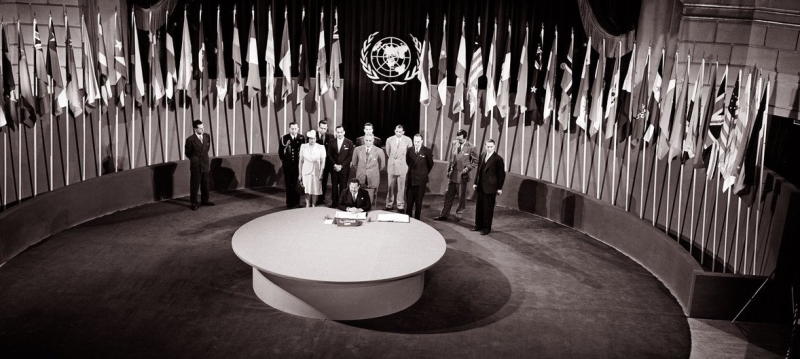- CA Yunus pays homage to Liberation War martyrs on Victory Day |
- Bangladesh capital market extends losing streak for second day |
- Bangladesh celebrates Victory Day Tuesday |
- 'Different govts presented history based on their own ideologies': JU VC |
UN Charter a ‘Living Miracle’ After 80 Years: Guterres

A delegation signs the UN Charter during the historic ceremony at the Veterans’ War Memorial Building in San Francisco on 26 June 1945. UN Photo/Yould
Nearly 80 years after its signing, the United Nations Charter remains a beacon of hope and a “living miracle,” said UN Secretary-General António Guterres at the opening of a multimedia exhibit titled “Reviving the Spirit of San Francisco” at UN Headquarters.
Standing beside the historic document that laid the foundation of the global organisation, Guterres called the Charter “more than parchment and ink,” describing it as “a promise – of peace, dignity, and cooperation among nations.”
The UN Charter was signed in San Francisco on 26 June 1945 by representatives of nearly 50 nations emerging from the horrors of the Second World War. It came into force on 24 October that year, marking the birth of the United Nations.
A Vision Born from War
UN General Assembly President Philémon Yang echoed the Secretary-General’s sentiments, saying the Charter embodied the determination of a war-ravaged world to choose peace, diplomacy, and global solidarity over conflict and destruction.
“For a world mired in endless cycles of conflict and human suffering, the Charter offered a path to a more peaceful and prosperous future,” Yang said.
Since its ratification, the Charter has paved the way for major international agreements, including the 1948 Universal Declaration of Human Rights and the recently adopted 2024 Pact for the Future.
Enduring Legacy
The UN Charter is not only a founding document but a legally binding treaty for all Member States. Over the decades, it has helped guide decolonisation efforts, promote justice, protect human rights, and advance sustainable development.
The exhibit highlights the enduring relevance of the Charter by showcasing historical artifacts, photos, and videos, illustrating how the ideals forged in 1945 continue to shape global cooperation today.
“As we look ahead, we would be wise to remember our past, celebrate our successes, and build our future on the foundation of the UN Charter,” said Yang.
Facing Modern Challenges
Guterres acknowledged the changing global landscape, with challenges such as climate change, digital transformation, and persistent inequalities. Yet, he emphasised that the Charter’s values remain as relevant as ever.
“The UN is a living miracle,” Guterres said. “And the women and men of the United Nations bring this miracle to life every day and everywhere.”

